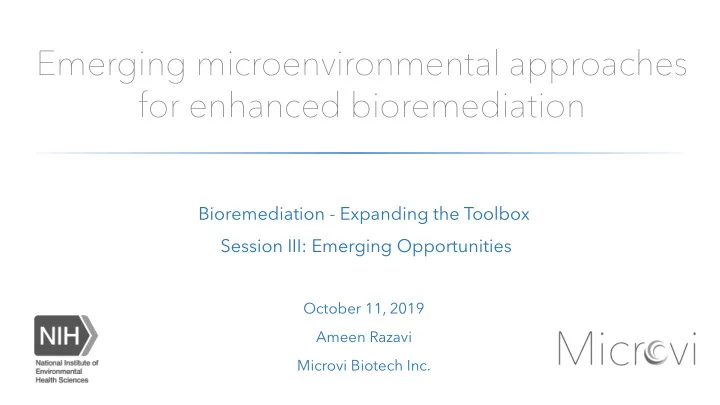

Emerging microenvironmental approaches for enhanced bioremediation Bioremediation - Expanding the Toolbox Session III: Emerging Opportunities October 11, 2019 Ameen Razavi Microvi Biotech Inc.
Presentation Outline Part I: I: Introduction to organic compounds as environmental contaminants • Cometabolism Co m Cometabolism is a promising bioremediation strategy • Key technical challenges in cometabolism-based bioremediation • Part II: II: Introduction to microenvironmental engineering • Mi Microenvironmental l The application of a selected microenvironmental engineering approach for • the bioremediation of chlorinated solvents Engineering En g Part III: III: Research trends in the applications of computational modeling • Predictive Mo Modeling g Use of microbiomics to build functional models for enhanced • bioremediation & F Future D Directions s 1
About Microvi Biotechnologies Microvi works at the intersection of materials science and biology to discover, design and implement next-generation industrial bioprocesses, focusing on water purification, wastewater treatment and reuse, and the production of biobased chemicals. Petroleum Lack of Clean Dependence Drinking Water Air Pollution Climate Environmental Change Degradation Polluted Wasteful Outdated Technologies Lakes and Infrastructure and Processes Rivers 2
Part I: Cometabolism
No No Image Ima e g Widespread occurrence of volatile organic compounds (VOCs) in drinking water Moran, M. J., Hamilton, P. A., & Zogorski, J. S. (2006). Volatile Organic Compounds in the Nation's Ground Water and Drinking-water Supply Wells: A Summary. US Department of the Interior, US Geological Survey. 4
No No Image Ima e g Introduction to aerobic cometabolism Cometabolism involves the degradation of • a secondary substrate when a general enzyme is induced by a primary substrate. Some contaminants may only be effectively • degraded through cometabolism Cometabolism may offer faster and more • efficient degradation than other pathways Cometabolism may consolidate the • biodegradation of different compounds sMMO: soluble methane monooxygenase TCE: trichloroethylene 5
No No Image Ima e g Technical challenges in the application of cometabolism for bioremediation Lack of control over the microbial consortia due to the reliance on indigenous organisms in the bioreactor or treatment zone The bioavailability of gaseous and/or sparingly soluble primary substrates is rate-limiting, leading to unpredictable induction kinetics Slow-growing target organisms for cometabolism can lead to long startup periods, instability, and competitive inhibition. 6
Part II: Microenvironmental Engineering
Microvi’s MicroNiche Engineering (MNE) Platform 8
The application of microenvironmental engineering for flexible implementation goals MB-COMET: Microvi biocatalysts developed for enhanced cometabolism. Supported by NIEHS SBIR/STTR (Contract 2R44ES024670) 9
Design of composite materials for reducing rate- limiting bottlenecks in aerobic cometabolism Supported by NIEHS SBIR/STTR (Contract 2R44ES024670) 10
Development of a continuous-flow prototype for the degradation of trichloroethylene (TCE) Supported by NIEHS SBIR/STTR (Contract 2R44ES024670) 11
Part III: Predictive Modeling & Future Directions
Microbiome research today is shifting towards predictive computational models Supported by NIEHS SBIR/STTR (Contract 1R41ES026541) 13
The application of various computational methodologies help detect key interactions Ability to better capture individual • heterogeneity within the microbiome Customizable platforms to apply to a • wide range of bioremediation situations and data inputs Integration with other modeling tools • for enhancing the reliability of predictions Leverage data generated from next- • generation tools and techniques for translation into practical applications Supported by NIEHS SBIR/STTR (Contract 1R41ES026541) 14
Future directions Improved microbiome tools and techniques for understanding complex Integration behaviors and interactions Microbiome Integration of new sciences and platforms into existing theoretical, economic and physical Computation infrastructure for remediation applications Use of multi-disciplinary platforms to translate fundamental data into functional systems 15
Thank you Ameen Razavi Microvi Biotech Inc. Email: info@microvi.com Phone: +1 (510) 344-0668
Recommend
More recommend